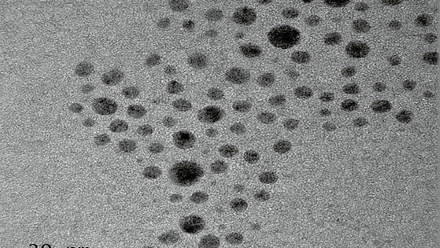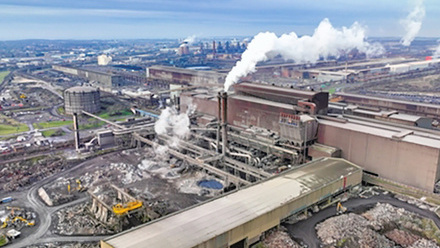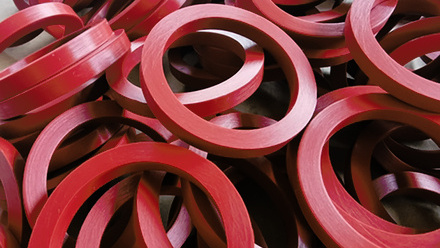Activating research at Diamond Light Source
The UK’s national synchrotron facility – Diamond Light Source – opened the doors to its new Active Materials Laboratory last year. Alex Brinded received a behind-the-scenes tour.
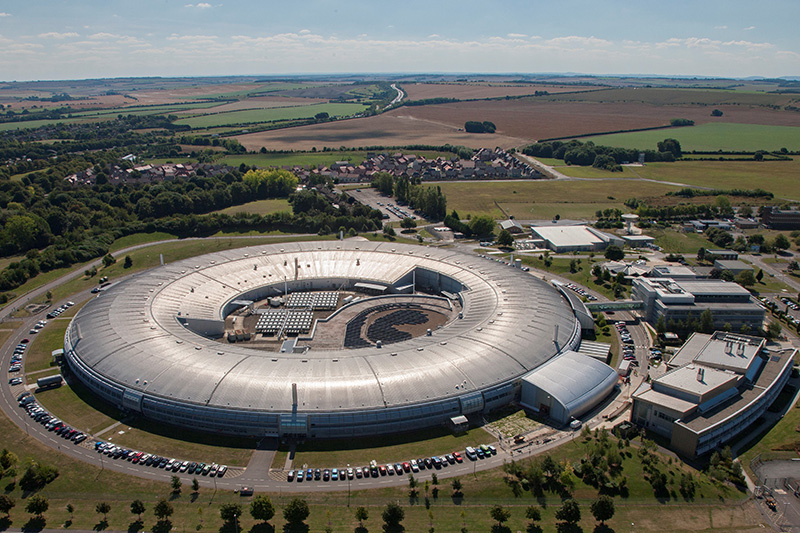
The suite of new labs at Diamond Light Source enables radioactive samples to be prepared onsite – a feat that allows researchers to perform experiments on ‘active materials’ that were previously impossible in the UK.
Set up more than 20 years ago, to design, build and operate the UK’s national synchrotron, Diamond says that the new Active Materials Laboratory (AML) significantly improves the capabilities for researchers in disciplines ranging from construction materials for nuclear energy facilities to waste remediation.
Principal Investigator Dr Fred Mosselmans, an integral part of AML’s development, introduced experienced beamline users on the tour who were already taking advantage of the new lab.
'I guess the hottest [most radioactive] experiment we’ve done so far was a group from Oxford University who brought some graphite samples that had been in Advanced Gas-cooled Reactors…they were the only group so far with samples ‘hot enough’ that they’ve actually had to manage the dose they are getting when they are handling the sample.'
He notes that the new site came to fruition following user feedback to progress active materials work at Diamond. Users flagged, 'what I need is somewhere I can handle my samples, without containment, beyond what you need for protection…'
The team is hoping that the AML will produce a surge of new radioactive material experiments being requested. 'It used to be between 15 and 20 experiments a year, then probably like 10 to 15 in the last two years as research slowed down because of COVID-19,' says Mosselmans. 'What we want to do is double that to at least 35 to 40 experiments, that’s our initial target – we hope to do that by about 2025.'
They are keen to entice existing users and attract radioactive materials researchers who don’t currently visit the synchrotron. '
'We’ve seen some increase in users already,' Mosselmans says. 'There are experiments like Susie’s [Professor Susannah Speller – see below] that we couldn’t have done in our previous lab. It’s also fusion related, which is obviously more publicly acceptable and efficient in some ways.'
Did you know?
- Diamond Light Source, as the UK’s national synchrotron, accelerates electrons around a loop that is more than half a kilometre in circumference to near light speeds, so they emit light 10 billion times brighter than the sun.
- This light is then harnessed into 33 ‘beamlines’, which are laboratories where users can study material using a machine 10,000 times more powerful than a traditional microscope.
- Over 80% of the facility is funded by the UK Government via the Science and Technology Facilities Council, which now sits under the arm of UK Research and Innovation (UKRI). The other 14% of shares are owned by Wellcome.
- The synchrotron is free at the point of access for researchers publishing papers for peer review, provided the results are made public.
- Industrial researchers can also access beamtime, including for proprietary research.
- Allocation of beamtime is via a peer-review process that selects proposals based on scientific merit and technical feasibility.
- There are 12 peer-review panels that meet twice a year to assess the proposals submitted for each six-month allocation period.
- The 12,000th peer-reviewed paper was recently published using research conducted at Diamond Light Source.
A new wave
Researchers can use the facility for free at the point of access, so long as they are making their research publicly available. They also have some companies and industrial pharmaceutical and chemicals specialists working with them, as well as engineering firms, including Rolls-Royce, who have done studies.
Mosselmans reflects that because it is difficult to move active materials across borders, many researchers are likely to use a synchrotron in their own country, such as the Deutsches Elektronen-Synchrotron in Hamburg, Germany, and the Swiss Light Source in Viligen, Switzerland. But he points out Diamond Light Source’s unique selling point. 'Even at synchrotrons where there is an active lab on the same campus, if you want to take samples from the lab to the beamline, you must go through a transfer procedure because you’re moving it from one institute to another. While here it’s all in the same institute. Certainly, in Europe there is no comparable lab to the AML.'
He continues, 'No changes have been made or planned for the beamlines to facilitate the anticipated influx of radioactive materials, apart from perhaps ventilation in some very rare cases. But the containment of the material once it’s on the beamline should be such that there’s almost no chance of a contamination breach.'
He envisages the largest number of AML experiments to be related to nuclear waste because of the amount of nuclear material storage in the UK that needs to be kept safely (as it is now) before eventual disposal. Mosselmans says that the research at the AML will assist with building a geological disposal facility (GDF), and address waste handling questions over the next 50 years or so before it can be put into the GDF.
But he also expects the facility to welcome progressive nuclear technology research. 'There are Engineers who are looking at new materials both for fission and fusion reactors. There will be people studying things like zirconium alloys, which are used in shielding or constructing in nuclear power stations and understanding how their physical properties change after years of irradiation.'
Another strand of the business model is for the Materials Research Facility at the UK Atomic Energy Authority site in Culham, Oxfordshire – which is another National Nuclear User Facility – to reduce the size of a sample so that it is not too radioactive and can be handled for analysis at Diamond.
Mosselmans denies that the site has been under any sort of government pressure to increase its active materials capability, with the yo-yoing of government and media sentiment on nuclear recently. 'There was a flat period in nuclear research, which was like 1990-ish to 2006 roughly. Something like 15 years. After that has been a slow resurgence until the last say five, six years where there has been a lot more interest.
'Our funding case is partly based on new nuclear, but it’s largely based on decommissioning and waste disposal. If I had to go into percentages, I would say we probably didn’t consider fusion much at all at the time. Probably 30% on new nuclear, and 65% on decommissioning and waste disposal.'
Guiding the light
Partway through my interview with Diamond’s new Physical Sciences Director Adrian Mancuso, he pauses mid-flow, 'I guess I am coming across as quite a nerd aren’t I...well, I am one, that’s me'. But he also exudes a passion for learning about people almost as much as science. Certainly, he seems extremely approachable, easy to talk to and eager about his new role at an exciting time in Diamond’s development. 'I enjoy getting out and meeting the people at the coal face. It is a great opportunity for me to learn'.
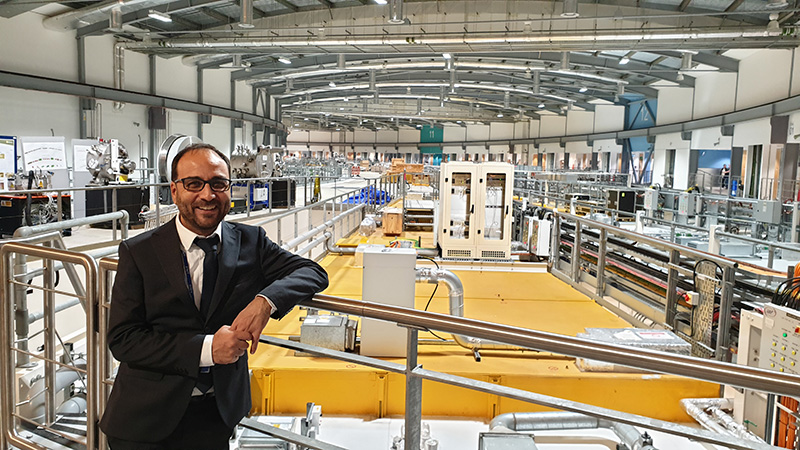
Indeed, earlier on the tour of the AML and beamlines, as we pass the control room, he gestures towards his offices, 'It would be easy to get overly focused with all that high-level strategy stuff in there, I like getting down here and finding out what people are up to.'
Like all good scientists, he is concerned with making sure he can verify the information he is getting, even going so far as to do his own fact-finding. 'I think I will co-supervise a couple of PhD students like I did at La Trobe University in Melbourne, Australia, and the Uppsala University in Sweden – it will be doable to set something similar up here. That way I get to experience using the facility through their eyes and as a user.'
But strategy he must consider, and he has strong ambitions for the facility’s future. 'One thing I think is important is to find synergies and collaborations, not just internally, but with other scientific institutions and researchers in the UK and across Europe.'
He is well placed for such a perspective, having previously been based at the European X-ray Free Electron Laser (XFEL) in Hamburg, Germany. He was Group Leader and Leading Scientist for the Single Particles, Clusters, and Biomolecules & Serial Femtosecond Crystallography Instrument Group since 2010.
Asked if he will miss the hands-on nature of science in his new role, he says, 'My old job at XFEL was operational and strategy as a leading scientist. I had about 30 people under me, so I haven’t been doing experiments exactly myself for a while…I do love planning and setting them up though.'
I ask him if the appreciation of different perspectives in his team was informed by growing up and studying in Melbourne and then working in Germany alongside people from all over Europe, as well as further afield?
'As well as my direct experience from where I have lived, it is the different perspectives and thoughts that people bring. I don’t believe diversity is just a worthwhile, human goal to achieve – it’s actually key for an effective creative organisation.'
Diamond hosts 786 scientists, engineers, support staff and technicians from 44 countries at the synchrotron facility. He enthuses, 'When I was playing boardgames after work with some colleagues one evening, I could see the different approaches and the different perspectives people had.'
If it sounds like he feels comfortable at Diamond, it is because he is, having served as a member of its Scientific Advisory Committee for over three years, helping to inform the technical and scientific questions impacting specification, design, commissioning and operation of the facility. Explaining how he initially got involved with Diamond, Mancuso says, 'the breadth of science at Diamond Light Source is what attracted me to the place'.
Mancuso has a PhD in Physics from the University of Melbourne where he focused on how to use laser-like X-rays for imaging and previously studied for his science degree with a major in Physics.
Where did his interest come from? 'My dad did the books for an engineering firm that delivered big projects across the Australian East coast…and he got interested in Engineering and went to night school. He had this Physics textbook lying around, and I was at primary school and just picked it up and really enjoyed it and just read it straight through.'
His areas of expertise include imaging using spatially coherent X-rays, as well as the simulation and modelling of experiments using appropriately detailed physical models. When asked how that background in modelling will apply to his new job, he says, 'I would be interested in setting up tools for modelling here so that we can use simulation to help us understand the data we collect experimentally.'
Earlier on the tour, we see one of the beamlines where there are longer-term experiments for three months at a time. It includes a piece of wood from the salvaged ship Mary Rose. I am informed later that part of a 3.67-million-year-old skeleton of one of our earliest ancestors found in South Africa was brought to the synchrotron for analysis in 2019 under lock and key.
'We do so much here, whether it is heritage science such as fragments from the Mary Rose or radioactive materials,' Mancuso says. There is a lot to admire, not least the scale of the facility itself with an assured helmsman.
Fielding off irradiation
Professor Susannah Speller, from the Materials Department at the University of Oxford, UK, and her team were the first to use the new Active Materials Laboratory last summer. They used the I20 beamline to conduct X-ray absorptions spectroscopy to probe how certain superconducting materials, which are being used for high-field magnets for small fusion tokamaks, behave under irradiation.
'The kind of superconductor that is really good for this application is called REBCOs (rare earth barium copper oxides), where the rare earth can be yttrium, it can be europium – pretty much any rare earth actually. The other high-temperature superconductors…don’t carry enough current at high enough field,' says Speller.
'In a tokamak, if you want to increase fusion power, one of the ways to do it is increasing the magnetic field, because the fusion power scales with magnetic fields to the power of four.
'One of the questions we want to answer is how similar are the defects that are being put into the material when we irradiate with helium ions, which are cheap and easy to use, compared to the real thing – the neutrons – that will be generated in a fusion reactor.'
What did the materials lab results show? 'What we saw was very interesting because we’ve done a lot of spectroscopy on the ion-irradiated and pristine materials. And when we did neutron-irradiated materials for the first time, we found that the changes we got between the pristine and irradiated…were really very similar to our previous experiments with helium ions…'
'If you irradiate at room temperature and then you warm them up a bit, they actually get better, slightly – because some of the defects you put in can move around and anneal out, and you actually get better superconducting properties again.
'What I really like is doing fundamental research, but when it’s connected to real applications that people need to know about…it’s a very exciting project.' She has just started a five-year fellowship focused on irradiation.



